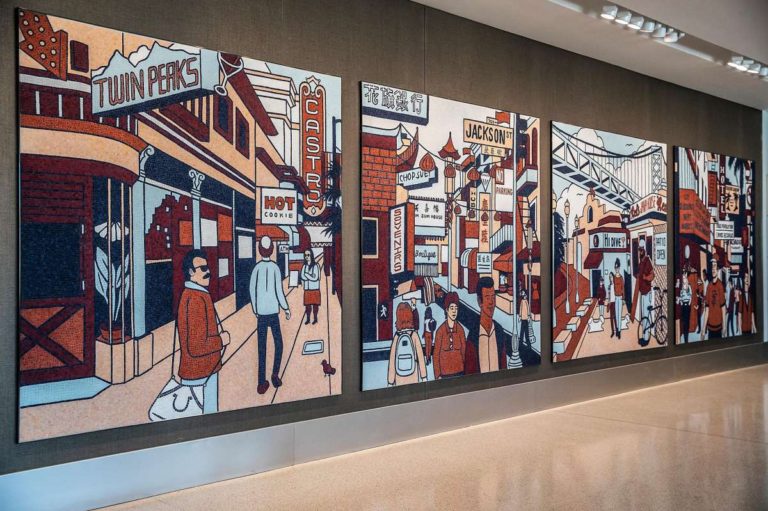
If there’s one thing to know about the architecture of airports, it is this: They’re like convention centers. They’re always in an expansion mode.
When one portion is unveiled with a flourish, you can guess that plans are being made to tear down something else. A relentless progression of building projects is the surest sign of success.
So even as San Francisco International Airport prepares to open the final boarding gates of its $2.4 billion Harvey Milk Terminal 1, officials were quick to say that the dust clouds and detours aren’t likely to vanish any time soon.
“Construction is never done at SFO,” said Doug Yakel, the airport’s public information officer.
His comment came after a tour to preview the new portions of the terminal that open to the public on Tuesday. There are seven boarding gates, along with a generous play area for young children with energy to burn. A first-ever corridor to SFO’s International Terminal will allow travelers to go back and forth without needing to go back through security. Speaking of security, the clearing within the metal detectors has been enlarged with a “recompose area” where, at the very least, you can put your shoes back on without fear of being run into from behind.
There are displays on Milk, who was San Francisco’s first openly gay elected official before being slain in 1979, and a corridor lined with with aviation artifacts from SFO’s museum. Public art includes four large tile mosaics by artist Emily Fromm that celebrate slices of San Francisco: Chinatown, the southern stretch of the Embarcadero, Castro Street and Mission Street.
“I wanted to steer away from highlighting obvious tourist attractions,” said Fromm, who lives in the Outer Sunset. “Go for deeper cuts.”

Four Corners mosaic by artist Emily Fromm on display inside Harvey Milk Terminal 1 at San Francisco International Airport.
Stephen Lam/The Chronicle
The improvements come 13 months after the opening of nine gates, a check-in lobby and the all-important baggage claim carousels. Three years from now, a lobby to the north is planned along with a spacious connection to the old Central Terminal, now known as T2.
They also follow a pandemic that descended last March and — no spoiler alert needed — brought normal life and the regional economy to a terrifying halt.
COVID-19 didn’t influence what debuts this week: “We’d already hired all the contractors and ordered all the materials we needed,” Yakel said, so it made sense to keep the gears in motion. But modernizing the section that links with T2 was put on hold for nearly a year: airport projects are funded by bonds that base their revenue models on the number of travelers who are expected from month to month.
“We haven’t even started demolition of that area,” Yakel said, referring to elements like the ticket counters that remain from long-ago days when the site held what opened in 1963 as the South Terminal. “We didn’t want the debt curve to accelerate as passengers were decelerating.”
Now, cross fingers, the worst of the pandemic is behind us. Passenger traffic at SFO has returned to 40% of pre-virus levels; this works out to roughly 30,000 daily, compared with just 2,000 intrepid fliers on a typical day in May of 2020.
Also delayed? Plans to remake the western wing of Terminal 3, which was built in 1971 and overhauled in 1979.
Part of the terminal was rebuilt in 2014, and SFO’s long-range plan was to update the rest as soon as Harvey Milk Terminal 1 was all wrapped up. Instead, design work won’t likely to begin in earnest until travel returns to pre-pandemic levels.
Trivia note: The lead architect for Terminal 3’s east wing upgrade, Gensler, also led the design team in the newest piece of Harvey Milk Terminal. As well as T2, which opened in 2011 on the site of 1954’s Central Terminal. The prior remake of the structure came in the early 1980s, a conversion that was designed by … Gensler.

The opening of the new terminal at San Francisco International Airport was a major public event in 1954. That structure is on the site of today’s Terminal 2, which opened in 2011.
Gordon Peters/The ChronicleMany of the forces behind the perpetual makeover are measurable. Planes get larger, for instance; several of the new gates can accommodate the two-level A380 mega-jets that hold as many as 500 people. The number of passengers using SFO climbed nearly 50% between 2000 and 2019, to 57.5 million.
Another factor is that SFO was one of the first U.S. airports to pursue the idea of terminal as amenity — a space that is part of the journey. Not just in the dramatic first impression, or cattle-chute efficiency, but the overall sense of a composed environment where you don’t mind killing an hour or two.
The “recompose area,” for instance, isn’t just a wide clearing beyond the security checkpoint. Construction workers last week were busy buffing the terrazzo floors — the featured hue is sky blue, a color selected for its soothing tone.
“It’s a balance of pragmatics and aesthetics,” said Ryan Fetters, an architect at Gensler who specializes in airport design. “SFO realized earlier than other airports that there are all kinds of journeys, and design should reflect that.”
The last piece of SFO built from scratch is the International Terminal that debuted in 2000, in the middle of the horseshoe formed by the three oft-altered terminals. Spacious, almost cathedral-like, it was conceived before online ticketing made grand ticketing halls functionally obsolete.
According to Yakel, there are no renovation plans — yet. But once Terminal 3 is completed, whenever that might be, the International Terminal is next on the list.
John King is The San Francisco Chronicle’s urban design critic. Email: jking@sfchronicle.com Twitter: @johnkingsfchron